MERCEDES-BENZ G-Class 2016 W463 Owner's Manual
Manufacturer: MERCEDES-BENZ, Model Year: 2016, Model line: G-Class, Model: MERCEDES-BENZ G-Class 2016 W463Pages: 302, PDF Size: 7.04 MB
Page 211 of 302
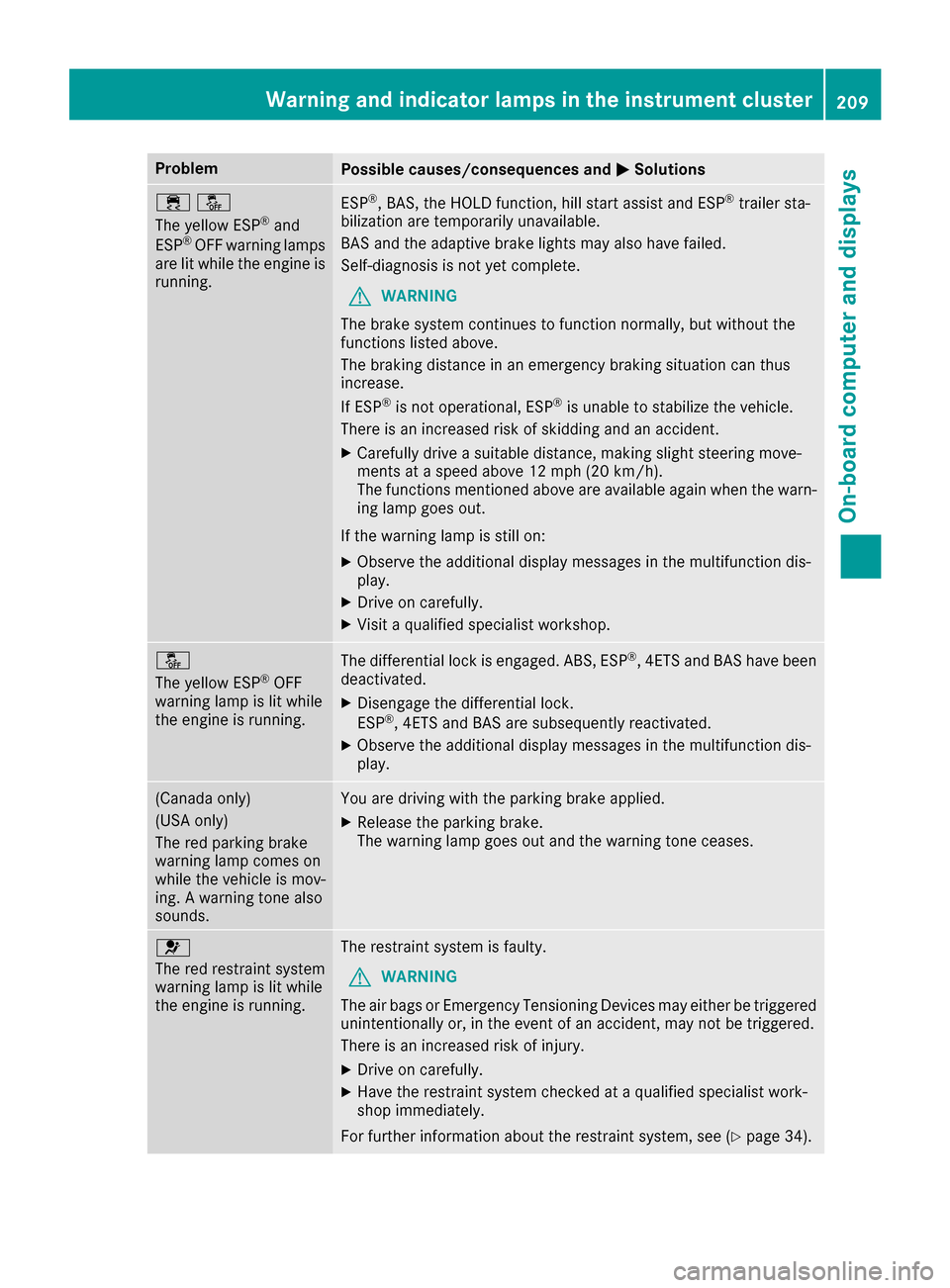
ProblemPossible causes/consequences andMSolutions
֌
The yellow ESP®and
ESP®OFF warning lamps
are lit while the engine is
running.
ESP®, BAS, the HOLD function, hill start assist and ESP®trailer sta-
bilization are temporarily unavailable.
BAS and the adaptive brake lights may also have failed.
Self-diagnosis is not yet complete.
GWARNING
The brake system continues to function normally, but without the
functions listed above.
The braking distance in an emergency braking situation can thus
increase.
If ESP
®is not operational, ESP®is unable to stabilize the vehicle.
There is an increased risk of skidding and an accident.
XCarefully drive a suitable distance, making slight steering move-
ments at a speed above 12 mph (20 km/h) .
The functions mentioned above are available again when the warn-
ing lamp goes out.
If the warning lamp is still on:
XObserve the additional display messages in the multifunction dis-
play.
XDrive on carefully.
XVisit a qualified specialist workshop.
å
The yellow ESP®OFF
warning lamp is lit while
the engine is running.
The differential lock is engaged. ABS, ESP®, 4ETS and BAS have been
deactivated.
XDisengage the differential lock.
ESP®, 4ETS and BAS are subsequently reactivated.
XObserve the additional display messages in the multifunction dis-
play.
(Canada only)
(USA only)
The red parking brake
warning lamp comes on
while the vehicle is mov-
ing. A warning tone also
sounds.You are driving with the parking brake applied.
XRelease the parking brake.
The warning lamp goes out and the warning tone ceases.
6
The red restraint system
warning lamp is lit while
the engine is running.The restraint system is faulty.
GWARNING
The air bags or Emergency Tensioning Devices may either be triggered
unintentionally or, in the event of an accident, may not be triggered.
There is an increased risk of injury.
XDrive on carefully.
XHave the restraint system checked at a qualified specialist work-
shop immediately.
For further information about the restraint system, see (
Ypage 34).
Warning and indicator lamps in the instrument cluster209
On-board computer and displays
Z
Page 212 of 302
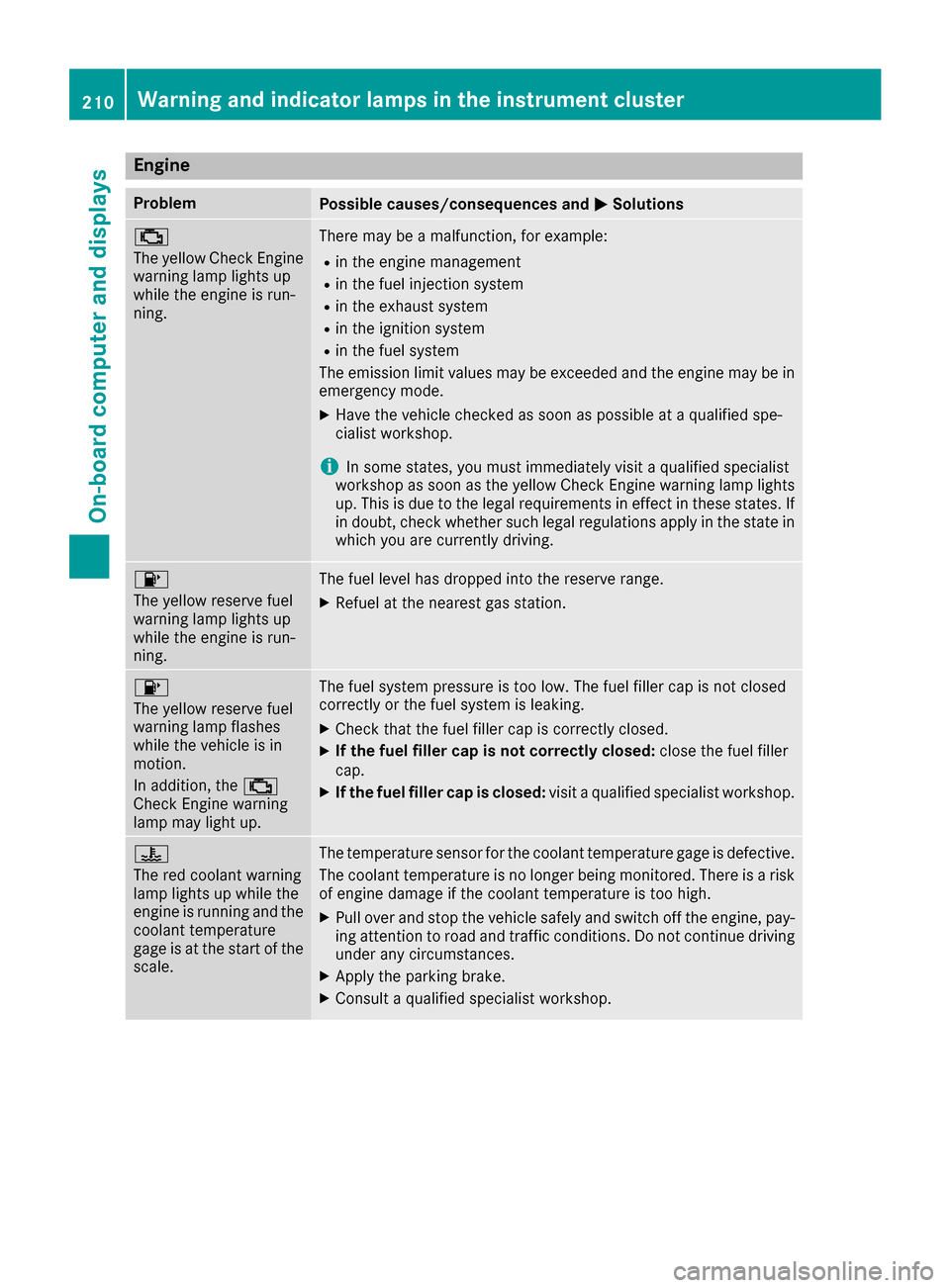
Engine
ProblemPossible causes/consequences andMSolutions
;
The yellow Check Engine
warning lamp lights up
while the engine is run-
ning.There may be a malfunction, for example:
Rin the engine management
Rin the fuel injection system
Rin the exhaust system
Rin the ignition system
Rin the fuel system
The emission limit values may be exceeded and the engine may be in
emergency mode.
XHave the vehicle checked as soon as possible at a qualified spe-
cialist workshop.
iIn some states, you must immediately visit a qualified specialist
workshop as soon as the yellow Check Engine warning lamp lights
up. This is due to the legal requirements in effect in these states. If
in doubt, check whether such legal regulations apply in the state in
which you are currently driving.
8
The yellow reserve fuel
warning lamp lights up
while the engine is run-
ning.The fuel level has dropped into the reserve range.
XRefuel at the nearest gas station.
8
The yellow reserve fuel
warning lamp flashes
while the vehicle is in
motion.
In addition, the ;
Check Engine warning
lamp may light up.The fuel system pressure is too low. The fuel filler cap is not closed
correctly or the fuel system is leaking.
XCheck that the fuel filler cap is correctly closed.
XIf the fuel filler cap is not correctly closed: close the fuel filler
cap.
XIf the fuel filler cap is closed: visit a qualified specialist workshop.
?
The red coolant warning
lamp lights up while the
engine is running and the
coolant temperature
gage is at the start of the
scale.The temperature sensor for the coolant temperature gage is defective.
The coolant temperature is no longer being monitored. There is a risk
of engine damage if the coolant temperature is too high.
XPull over and stop the vehicle safely and switch off the engine, pay-
ing attention to road and traffic conditions. Do not continue driving
under any circumstances.
XApply the parking brake.
XConsult a qualified specialist workshop.
210Warning and indicator lamps in the instrument cluster
On-board computer and displays
Page 213 of 302

ProblemPossible causes/consequences andMSolutions
?
The red coolant warning
lamp comes on while the
engine is running.The coolant level is too low.
!Avoid making long journeys with too little coolant in the engine
cooling system. The engine will otherwise be damaged.
If the coolant level is correct, the airflow to the engine radiator may be blocked or the electric engine radiator fan may be malfunctioning.
The coolant is too hot and the engine is no longer being cooled suffi-
ciently.
XObserve the additional display messages in the multifunction dis-
play.
XPull over and stop the vehicle safely and switch off the engine, pay-ing attention to road and traffic conditions.
XApply the parking brake.
XLeave the vehicle and keep a safe distance from the vehicle until the
engine has cooled down.
XCheck the coolant level and add coolant, observing the warning
notes (Ypage 238).
XIf you need to add coolant more often than usual, have the engine
coolant system checked.
XMake sure that the air supply to the engine radiator is not blocked,e.g. by snow, slush or ice.
XDo not start the engine again until the coolant temperature is below
248 ‡ (120 †). Otherwise, the engine could be damaged.
XDrive to the nearest qualified specialist workshop.
XAvoid subjecting the engine to heavy loads, e.g. driving in moun-
tainous terrain, and stop-start driving.
?
The red coolant warning
lamp comes on while the
engine is running. A
warning tone also
sounds.The coolant temperature has exceeded 248 ‡(120 †). The airflow to
the engine radiator may be blocked or the coolant level may be too
low.
GWARNING
The engine is not being cooled sufficiently and may be damaged.
Do not drive when your engine is overheated. This can cause some
fluids which may have leaked into the engine compartment to catch
fire.
Steam from the overheated engine can also cause serious burns which
can occur just by opening the hood.
There is a risk of injury.
XObserve the additional display messages in the multifunction dis-
play.
XPull over and stop the vehicle safely and switch off the engine, pay- ing attention to road and traffic conditions.
XSecure the vehicle against rolling away (Ypage 130).
XLeave the vehicle and keep a safe distance from the vehicle until the
engine has cooled down.
XCheck the coolant level and add coolant, observing the warning
notes (Ypage 238).
Warning and indicator lamps in the instrument cluster211
On-board computer and displays
Z
Page 214 of 302
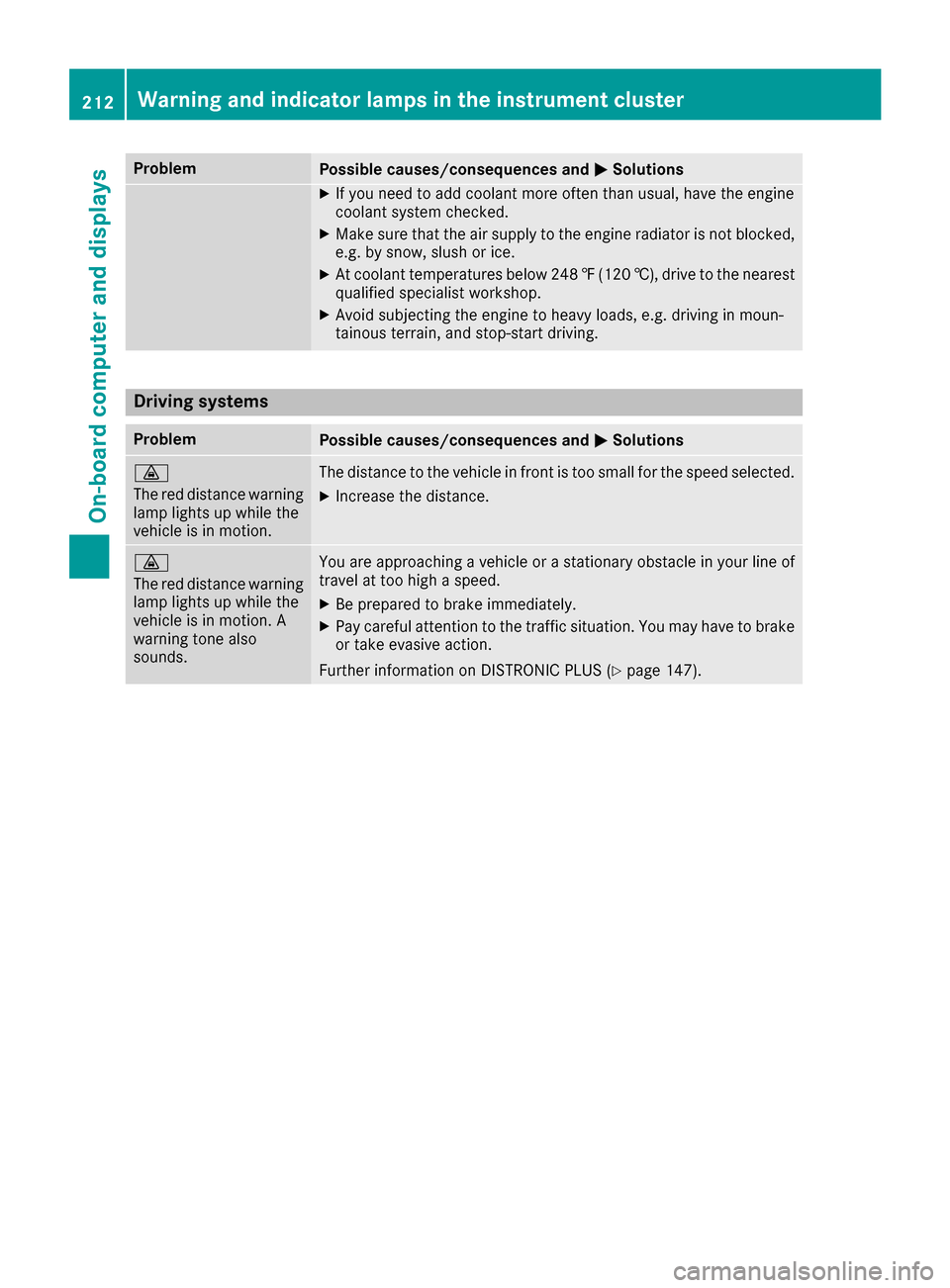
ProblemPossible causes/consequences andMSolutions
XIf you need to add coolant more often than usual, have the engine
coolant system checked.
XMake sure that the air supply to the engine radiator is not blocked,
e.g. by snow, slush or ice.
XAt coolant temperatures below 248 ‡(120 †), drive to the nearest
qualified specialist workshop.
XAvoid subjecting the engine to heavy loads, e.g. driving in moun-
tainous terrain, and stop-start driving.
Driving systems
ProblemPossible causes/consequences and MSolutions
·
The red distance warning
lamp lights up while the
vehicle is in motion.The distance to the vehicle in front is too small for the speed selected.
XIncrease the distance.
·
The red distance warning
lamp lights up while the
vehicle is in motion. A
warning tone also
sounds.You are approaching a vehicle or a stationary obstacle in your line of
travel at too high a speed.
XBe prepared to brake immediately.
XPay careful attention to the traffic situation. You may have to brake
or take evasive action.
Further information on DISTRONIC PLUS (
Ypage 147).
212Warning and indicator lamps in the instrument cluster
On-board computer and displays
Page 215 of 302
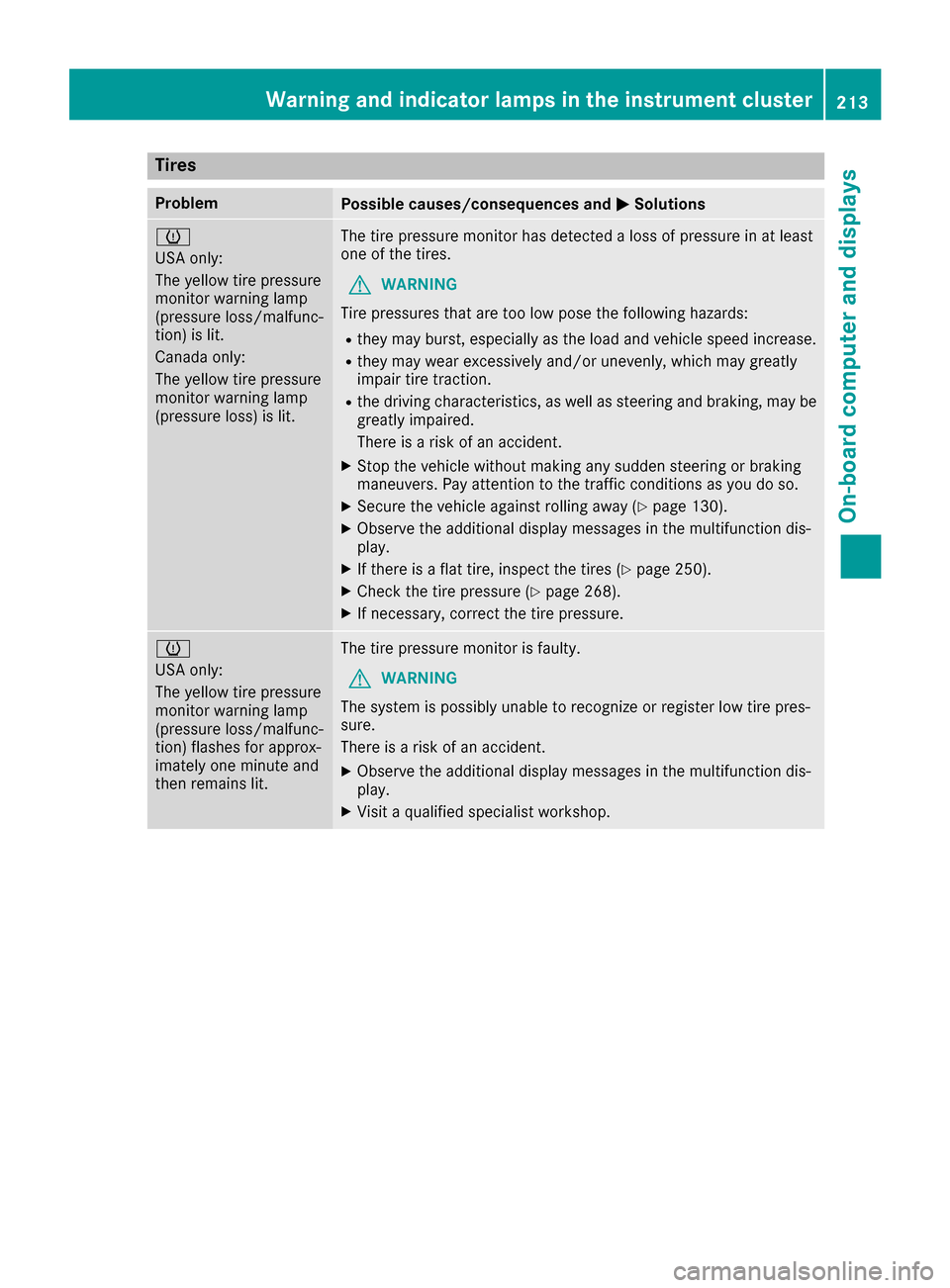
Tires
ProblemPossible causes/consequences andMSolutions
h
USA only:
The yellow tire pressure
monitor warning lamp
(pressure loss/malfunc-
tion) is lit.
Canada only:
The yellow tire pressure
monitor warning lamp
(pressure loss) is lit.The tire pressure monitor has detected a loss of pressure in at least
one of the tires.
GWARNING
Tire pressures that are too low pose the following hazards:
Rthey may burst, especially as the load and vehicle speed increase.
Rthey may wear excessively and/or unevenly, which may greatly
impair tire traction.
Rthe driving characteristics, as well as steering and braking, may be
greatly impaired.
There is a risk of an accident.
XStop the vehicle without making any sudden steering or braking
maneuvers. Pay attention to the traffic conditions as you do so.
XSecure the vehicle against rolling away (Ypage 130).
XObserve the additional display messages in the multifunction dis-
play.
XIf there is a flat tire, inspect the tires (Ypage 250).
XCheck the tire pressure (Ypage 268).
XIf necessary, correct the tire pressure.
h
USA only:
The yellow tire pressure
monitor warning lamp
(pressure loss/malfunc-
tion) flashes for approx-
imately one minute and
then remains lit.The tire pressure monitor is faulty.
GWARNING
The system is possibly unable to recognize or register low tire pres-
sure.
There is a risk of an accident.
XObserve the additional display messages in the multifunction dis-
play.
XVisit a qualified specialist workshop.
Warning and indicator lamps in the instrument cluster213
On-board computer and displays
Z
Page 216 of 302
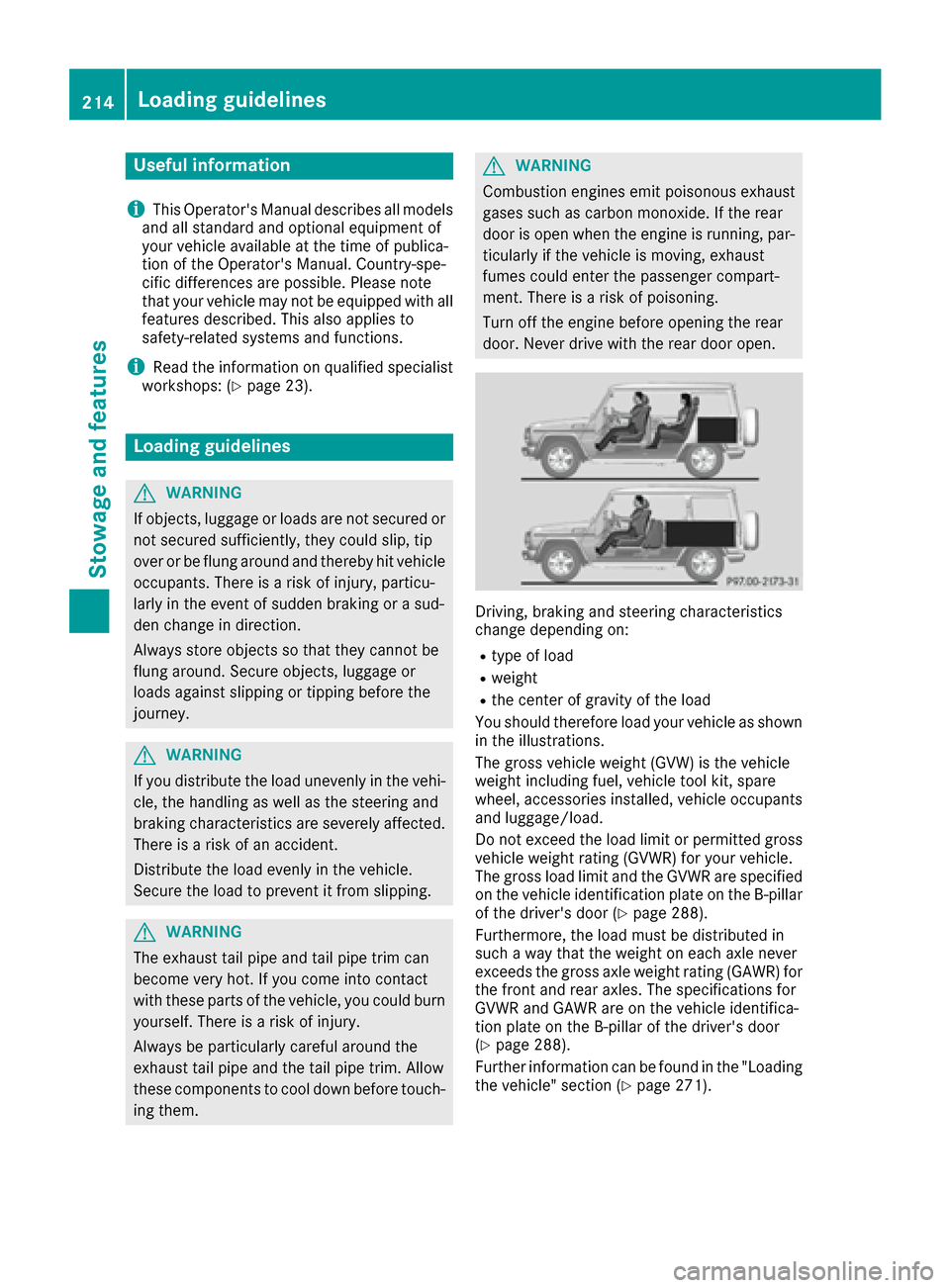
Useful information
i
This Operator's Manual describes all models
and all standard and optional equipment of
your vehicle available at the time of publica-
tion of the Operator's Manual. Country-spe-
cific differences are possible. Please note
that your vehicle may not be equipped with all
features described. This also applies to
safety-related systems and functions.
iRead the information on qualified specialist
workshops: (Ypage 23).
Loading guidelines
GWARNING
If objects, luggage or loads are not secured or
not secured sufficiently, they could slip, tip
over or be flung around and thereby hit vehicle
occupants. There is a risk of injury, particu-
larly in the event of sudden braking or a sud-
den change in direction.
Always store objects so that they cannot be
flung around. Secure objects, luggage or
loads against slipping or tipping before the
journey.
GWARNING
If you distribute the load unevenly in the vehi- cle, the handling as well as the steering and
braking characteristics are severely affected.
There is a risk of an accident.
Distribute the load evenly in the vehicle.
Secure the load to prevent it from slipping.
GWARNING
The exhaust tail pipe and tail pipe trim can
become very hot. If you come into contact
with these parts of the vehicle, you could burn
yourself. There is a risk of injury.
Always be particularly careful around the
exhaust tail pipe and the tail pipe trim. Allow
these components to cool down before touch-
ing them.
GWARNING
Combustion engines emit poisonous exhaust
gases such as carbon monoxide. If the rear
door is open when the engine is running, par-
ticularly if the vehicle is moving, exhaust
fumes could enter the passenger compart-
ment. There is a risk of poisoning.
Turn off the engine before opening the rear
door. Never drive with the rear door open.
Driving, braking and steering characteristics
change depending on:
Rtype of load
Rweight
Rthe center of gravity of the load
You should therefore load your vehicle as shown
in the illustrations.
The gross vehicle weight (GVW) is the vehicle
weight including fuel, vehicle tool kit, spare
wheel, accessories installed, vehicle occupants
and luggage/load.
Do not exceed the load limit or permitted gross
vehicle weight rating (GVWR) for your vehicle.
The gross load limit and the GVWR are specified
on the vehicle identification plate on the B-pillar
of the driver's door (
Ypage 288).
Furthermore, the load must be distributed in
such a way that the weight on each axle never
exceeds the gross axle weight rating (GAWR) for
the front and rear axles. The specifications for
GVWR and GAWR are on the vehicle identifica-
tion plate on the B-pillar of the driver's door
(
Ypage 288).
Further information can be found in the "Loading
the vehicle" section (
Ypage 271).
214Loading guidelines
Stowage and features
Page 217 of 302
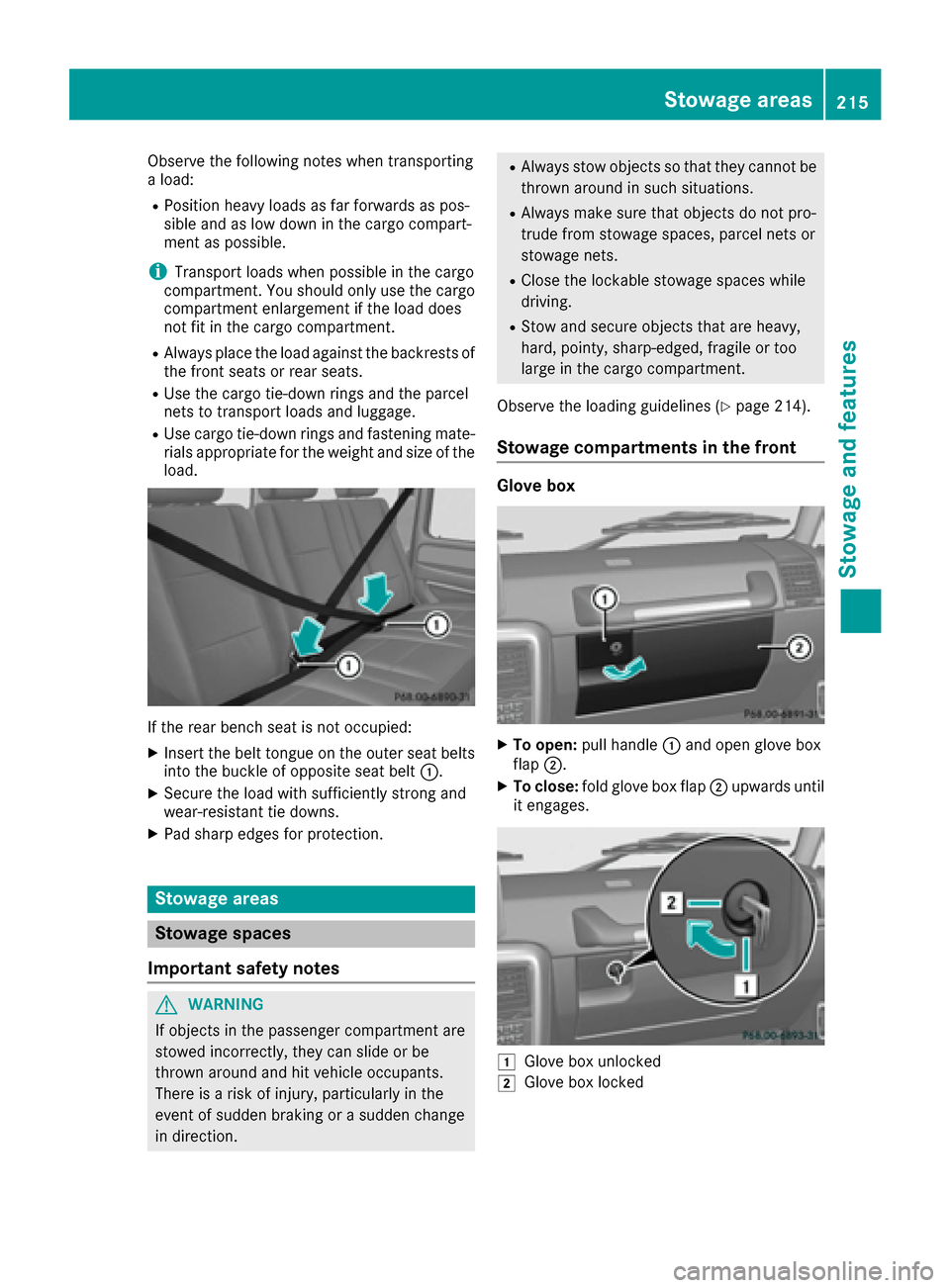
Observe the following notes when transporting
a load:
RPosition heavy loads as far forwards as pos-
sible and as low down in the cargo compart-
ment as possible.
iTransport loads when possible in the cargo
compartment. You should only use the cargo
compartment enlargement if the load does
not fit in the cargo compartment.
RAlways place the load against the backrests of
the front seats or rear seats.
RUse the cargo tie-down rings and the parcel
nets to transport loads and luggage.
RUse cargo tie-down rings and fastening mate-
rials appropriate for the weight and size of the load.
If the rear bench seat is not occupied:
XInsert the belt tongue on the outer seat belts
into the buckle of opposite seat belt :.
XSecure the load with sufficiently strong and
wear-resistant tie downs.
XPad sharp edges for protection.
Stowage areas
Stowage spaces
Important safety notes
GWARNING
If objects in the passenger compartment are
stowed incorrectly, they can slide or be
thrown around and hit vehicle occupants.
There is a risk of injury, particularly in the
event of sudden braking or a sudden change
in direction.
RAlways stow objects so that they cannot be
thrown around in such situations.
RAlways make sure that objects do not pro-
trude from stowage spaces, parcel nets or
stowage nets.
RClose the lockable stowage spaces while
driving.
RStow and secure objects that are heavy,
hard, pointy, sharp-edged, fragile or too
large in the cargo compartment.
Observe the loading guidelines (
Ypage 214).
Stowage compartments in the front
Glove box
XTo open: pull handle :and open glove box
flap ;.
XTo close: fold glove box flap ;upwards until
it engages.
1Glove box unlocked
2Glove box locked
Stowage areas215
Stowage and features
Z
Page 218 of 302
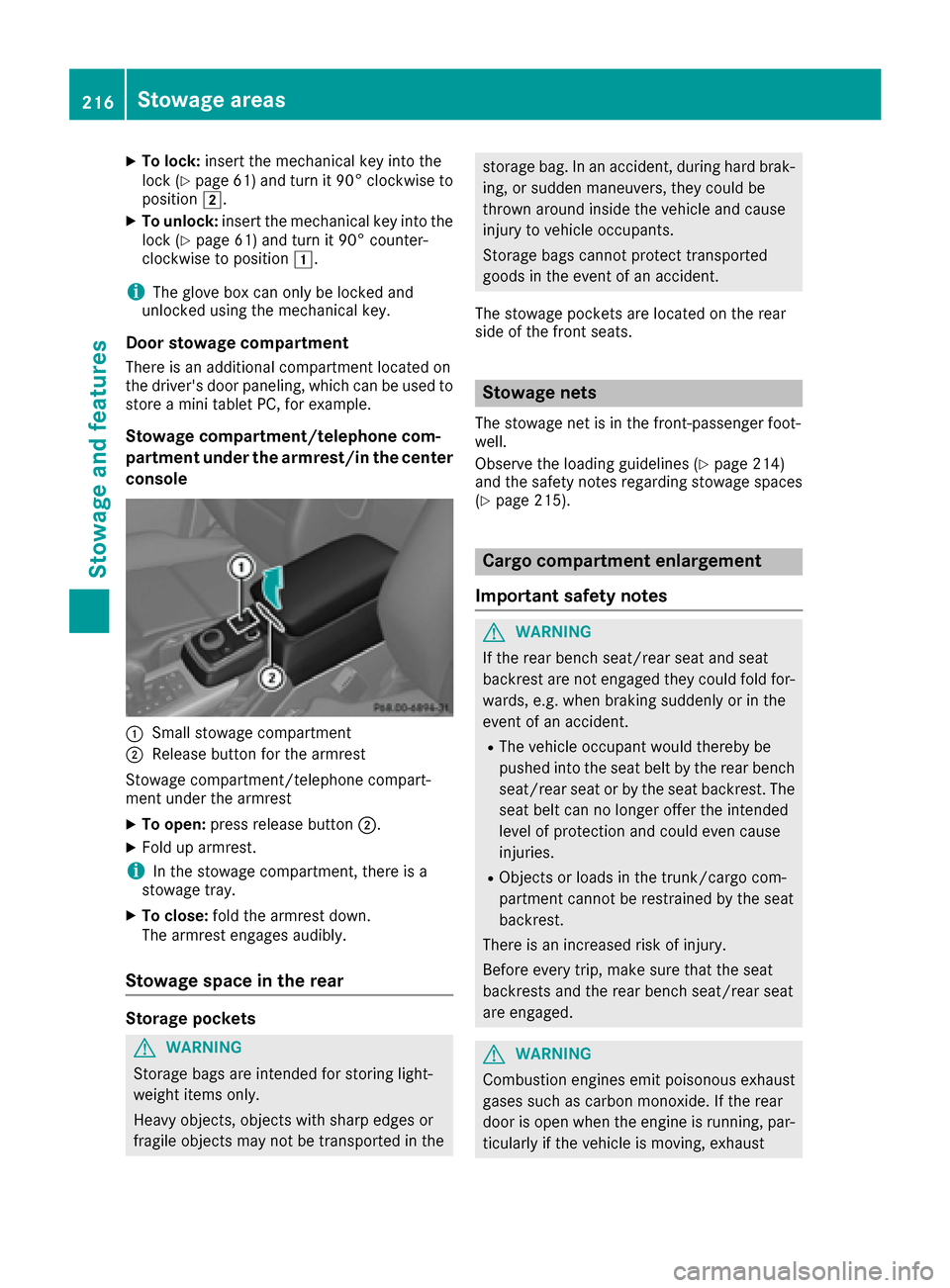
XTo lock:insert the mechanical key into the
lock (Ypage 61) and turn it 90° clockwise to
position 2.
XTo unlock: insert the mechanical key into the
lock (Ypage 61) and turn it 90° counter-
clockwise to position 1.
iThe glove box can only be locked and
unlocked using the mechanical key.
Door stowage compartment
There is an additional compartment located on
the driver's door paneling, which can be used to
store a mini tablet PC, for example.
Stowage compartment/telephone com-
partment under the armrest/in the center
console
:Small stowage compartment
;Release button for the armrest
Stowage compartment/telephone compart-
ment under the armrest
XTo open: press release button ;.
XFold up armrest.
iIn the stowage compartment, there is a
stowage tray.
XTo close: fold the armrest down.
The armrest engages audibly.
Stowage space in the rear
Storage pockets
GWARNING
Storage bags are intended for storing light-
weight items only.
Heavy objects, objects with sharp edges or
fragile objects may not be transported in the
storage bag. In an accident, during hard brak-
ing, or sudden maneuvers, they could be
thrown around inside the vehicle and cause
injury to vehicle occupants.
Storage bags cannot protect transported
goods in the event of an accident.
The stowage pockets are located on the rear
side of the front seats.
Stowage nets
The stowage net is in the front-passenger foot-
well.
Observe the loading guidelines (
Ypage 214)
and the safety notes regarding stowage spaces
(
Ypage 215).
Cargo compartment enlargement
Important safety notes
GWARNING
If the rear bench seat/rear seat and seat
backrest are not engaged they could fold for-
wards, e.g. when braking suddenly or in the
event of an accident.
RThe vehicle occupant would thereby be
pushed into the seat belt by the rear bench
seat/rear seat or by the seat backrest. The
seat belt can no longer offer the intended
level of protection and could even cause
injuries.
RObjects or loads in the trunk/cargo com-
partment cannot be restrained by the seat
backrest.
There is an increased risk of injury.
Before every trip, make sure that the seat
backrests and the rear bench seat/rear seat
are engaged.
GWARNING
Combustion engines emit poisonous exhaust
gases such as carbon monoxide. If the rear
door is open when the engine is running, par-
ticularly if the vehicle is moving, exhaust
216Stowage areas
Stowag ean d features
Page 219 of 302
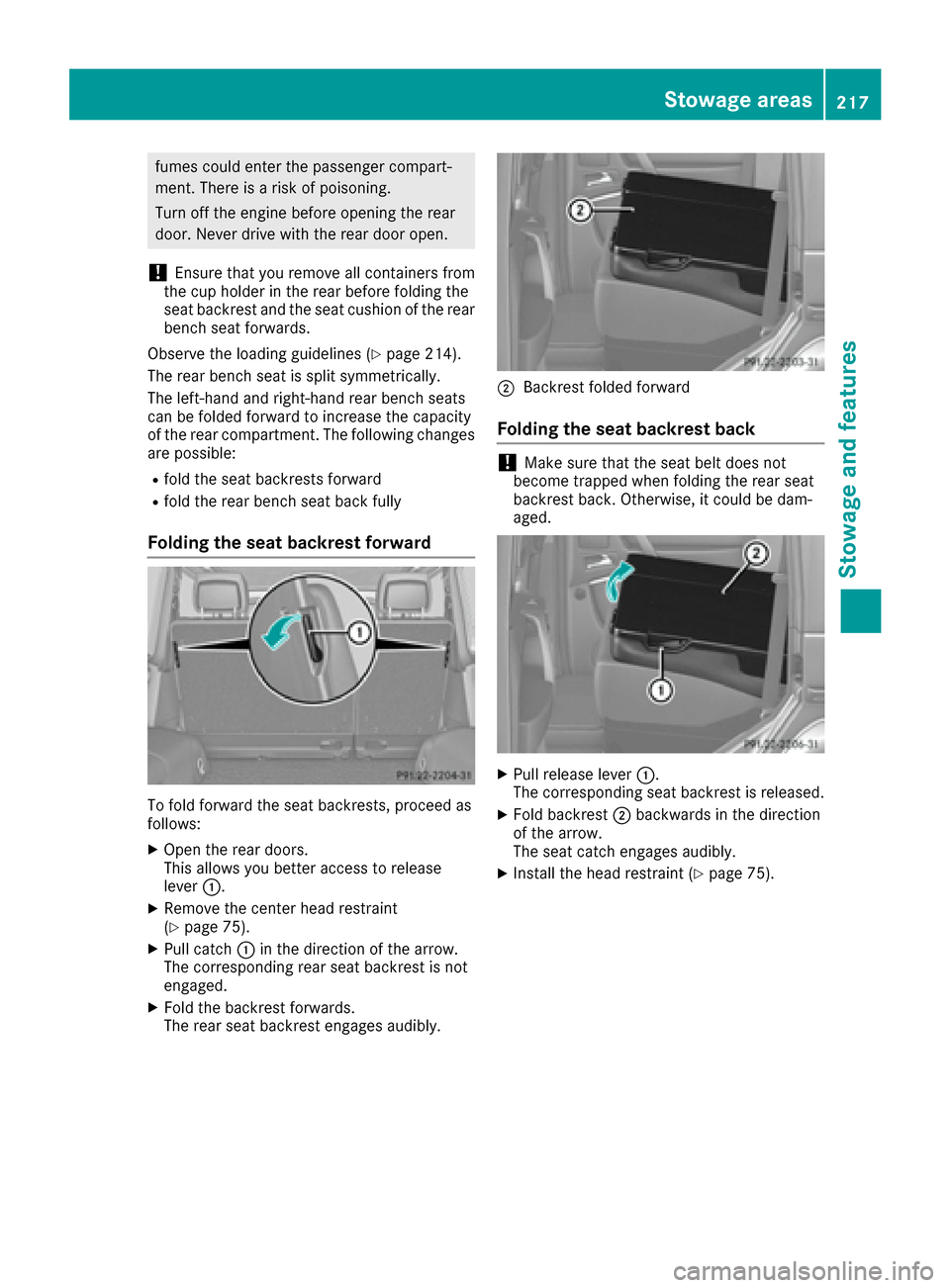
fumes could enter the passenger compart-
ment. There is a risk of poisoning.
Turn off the engine before opening the rear
door. Never drive with the rear door open.
!Ensure that you remove all containers from
the cup holder in the rear before folding the
seat backrest and the seat cushion of the rear
bench seat forwards.
Observe the loading guidelines (
Ypage 214).
The rear bench seat is split symmetrically.
The left-hand and right-hand rear bench seats
can be folded forward to increase the capacity
of the rear compartment. The following changes
are possible:
Rfold the seat backrests forward
Rfold the rear bench seat back fully
Folding the seat backrest forward
To fold forward the seat backrests, proceed as
follows:
XOpen the rear doors.
This allows you better access to release
lever :.
XRemove the center head restraint
(Ypage 75).
XPull catch :in the direction of the arrow.
The corresponding rear seat backrest is not
engaged.
XFold the backrest forwards.
The rear seat backrest engages audibly.
;Backrest folded forward
Folding the seat backrest back
!Make sure that the seat belt does not
become trapped when folding the rear seat
backrest back. Otherwise, it could be dam-
aged.
XPull release lever :.
The corresponding seat backrest is released.
XFold backrest ;backwards in the direction
of the arrow.
The seat catch engages audibly.
XInstall the head restraint (Ypage 75).
Stowage areas217
Stowage and features
Z
Page 220 of 302
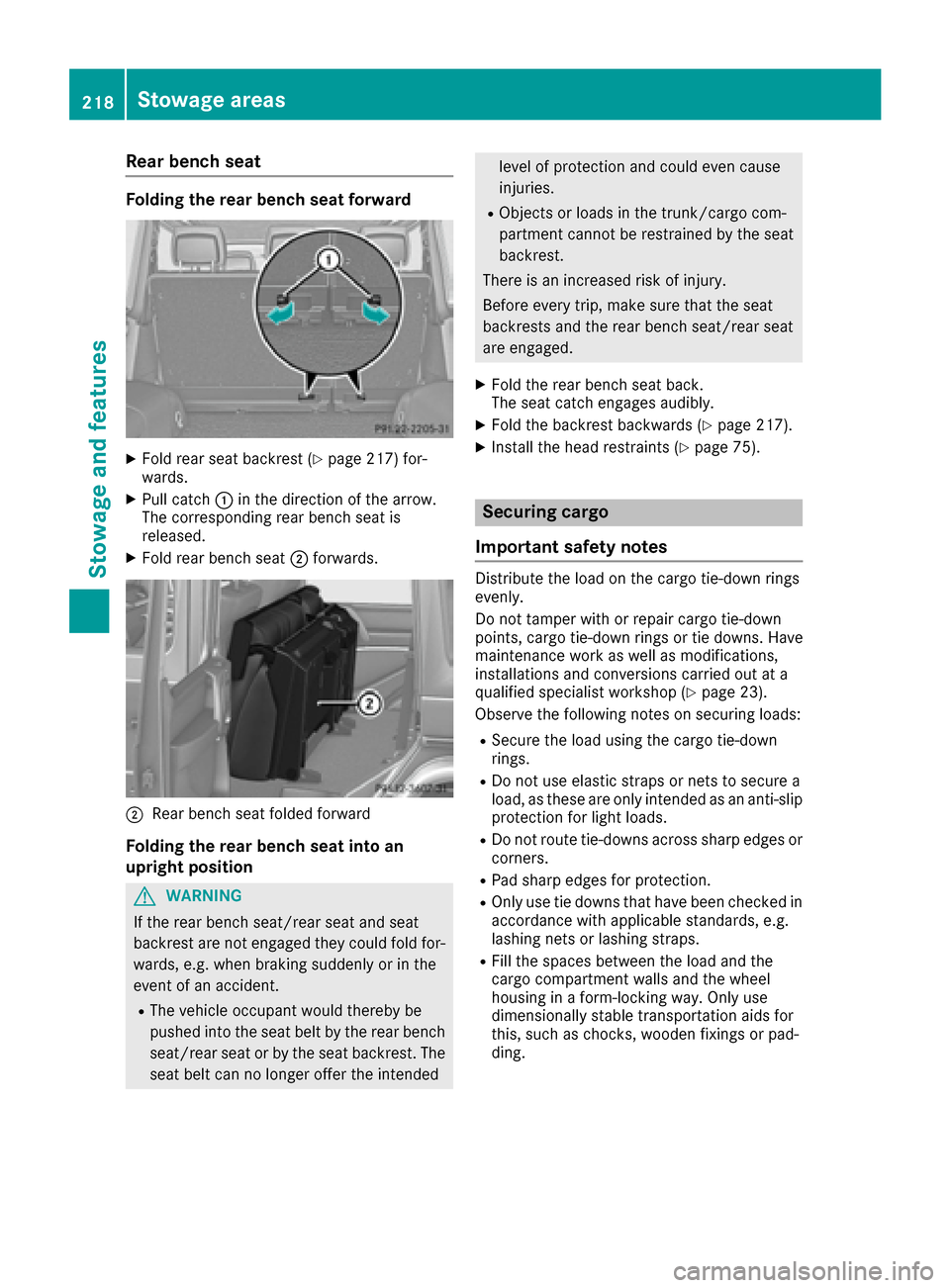
Rear bench seat
Folding the rear bench seat forward
XFold rear seat backrest (Ypage 217) for-
wards.
XPull catch :in the direction of the arrow.
The corresponding rear bench seat is
released.
XFold rear bench seat ;forwards.
;Rear bench seat folded forward
Folding the rear bench seat into an
upright position
GWARNING
If the rear bench seat/rear seat and seat
backrest are not engaged they could fold for-
wards, e.g. when braking suddenly or in the
event of an accident.
RThe vehicle occupant would thereby be
pushed into the seat belt by the rear bench
seat/rear seat or by the seat backrest. The
seat belt can no longer offer the intended
level of protection and could even cause
injuries.
RObjects or loads in the trunk/cargo com-
partment cannot be restrained by the seat
backrest.
There is an increased risk of injury.
Before every trip, make sure that the seat
backrests and the rear bench seat/rear seat
are engaged.
XFold the rear bench seat back.
The seat catch engages audibly.
XFold the backrest backwards (Ypage 217).
XInstall the head restraints (Ypage 75).
Securing cargo
Important safety notes
Distribute the load on the cargo tie-down rings
evenly.
Do not tamper with or repair cargo tie-down
points, cargo tie-down rings or tie downs. Have
maintenance work as well as modifications,
installations and conversions carried out at a
qualified specialist workshop (
Ypage 23).
Observe the following notes on securing loads:
RSecure the load using the cargo tie-down
rings.
RDo not use elastic straps or nets to secure a
load, as these are only intended as an anti-slip
protection for light loads.
RDo not route tie-downs across sharp edges or
corners.
RPad sharp edges for protection.
ROnly use tie downs that have been checked in
accordance with applicable standards, e.g.
lashing nets or lashing straps.
RFill the spaces between the load and the
cargo compartment walls and the wheel
housing in a form-locking way. Only use
dimensionally stable transportation aids for
this, such as chocks, wooden fixings or pad-
ding.
218Stowage areas
Stowage and features